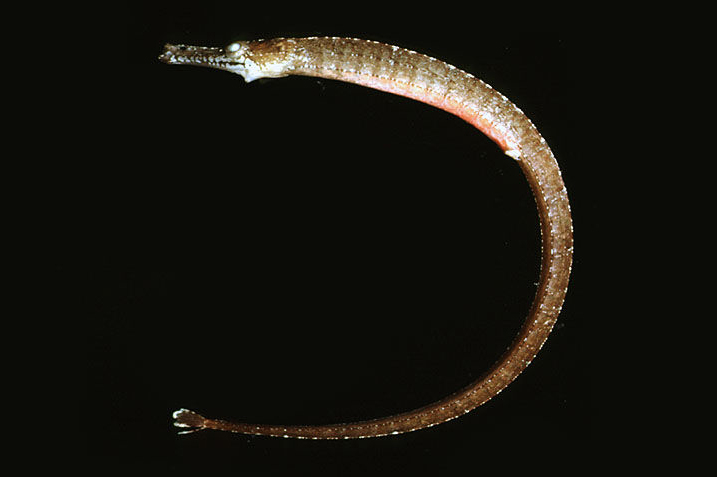Bluespeckled Pipefish, Hippichthys cyanospilos (Bleeker 1854)

A Bluespeckled Pipefish, Hippichthys cyanospilos, from Blanche Bay, New Britain, Papua New Guinea. Source: John E. Randall / FishBase. License: CC by Attribution-NonCommercial
Bluespeckled Pipefish varies in colour from pale yellow or greenish, to dark brown, usually with pale mottled saddles or spots on the back and sides. The dorsal finrays are distinctly spotted and the snout has light and dark bars on the underside. This tropical species often lives among mangroves in tidal estuaries and creeks.
Bluespeckled Pipefish, Hippichthys cyanospilos (Bleeker 1854)
More Info
|
Distribution |
Widespread in the tropical Indo-West Pacific; Red Sea and east African coast to Fiji, Philippines and Australia; inhabiting brackish shallow-water environments in estuaries and lower reaches of coastal rivers and streams, often amongst mangroves to 4 m. |
|
Features |
Meristics: D 20-28; P 13-16 (usually 14-15); Trunk rings 12-14; Tail rings 32-35. Head and body: Head length 7.5-9.8 in SL; snout tapering; snout length moderate, 13.-2.6 in head length; snout depth 3.0-5.4 in snout length; superior trunk and tail ridges discontinuous; lateral snout ridge usually distinct; scutella not keeled; lateral trunk ridge deflected ventrally at posterior end; inferior trunk and tail ridges continuous; subadults and adults with deep trunk and tail ridges; ventral surface distinctly V-shaped. Fins: Pectoral fin base not strongly protruding laterally, crossed by two low ridges; dorsal fin base not elevated; dorsal fin membrane closely bound to fin rays; anal fin narrow. |
|
Size |
To 16 cm |
|
Colour |
Variable pale yellow to light brown to almost black; dorsum and sides of body plain coloured, mottled or blotched; dorsal fin whitish with small dark spots. |
|
Feeding |
Preys on small planktonic crustaceans. |
|
Biology |
Reproduction: Ovoviviparous (gives birth to live young). The eggs are brooded by the males in a brood pouch under the tail with pouch protective plates and an everted pouch closure. Males may begin brooding at 65-75 mm SL. Eggs: Brood pouch eggs are oval and crowded in up to 10-11 transverse rows (typically in a single layer) across the upper part of pouch folds and dorsal surface of the pouch. Eggs are not contained in a continuous gelatinous matrix but are covered by protective folds which meet or overlap on the ventral midline. Larvae: Advanced larvae are often present in the brood pouch. |
|
Fisheries |
None. |
|
Conservation |
Australian Government Legislation: Marine listed under the Environment Protection and Biodiversity Conservation Act 1999. |
|
Similar Species |
H. cyanospilos is easily distinguished from other members of the genus by modal trunk ring and total ring counts (13 and 45-48 versus 15 and 51-57), strongly spotted dorsal fin rays and the lack of bars on the ventral surface and sides of the trunk. The relative head length of H. cyanospilus is approximately intermediate between H. heptagonus and H. spicifer. |
|
Etymology |
Hippichthys is from the Greek ippos meaning horse and the Greek ichthys for fish. The specific name cyanospilos is from the Greek cyano meaning blue, and spilos meaning spots. |
|
Species Citation |
Bleeker 1854, Natuurkundig Tijdschrift voor Nederlandsch Indië 6: 114, Banda Neira, Banda Islands, Indonesia. |
|
Author |
Thompson, Vanessa J. & Dianne J, Bray |
Bluespeckled Pipefish, Hippichthys cyanospilos (Bleeker 1854)
References
Allen, G.R. & M. Adrim. 2003. Coral reef fishes of Indonesia. Zool. Stud. 42(1): 1-72.
Bleeker, P. 1854. Derde bijdrage tot de kennis der ichthyologische fauna van de Bandaeilanden (1). Nat. Tijdschr. Ned. Ind. 6: 89-114.
Dawson, C.E. 1978. Review of the Indo-Pacific fish genus Hippichthys (Syngnathidae). Proc. Biol. Soc. Wash. 91(1): 132-157.
Dawson, C.E. 1985. Indo-Pacific Pipefishes (Red Sea to the Americas). Gulf Coast Research Laboratory, Ocean Springs, Mississippi. 230 pp.
Dawson, C.E. 1986. Family No. 145: Syngnathidae. pp. 445-458. In Smith M.M. & P.C. Heemstra (eds.) Smiths' sea fishes. Macmillan, Johannesburg South Africa. 1047 pp, 144 pls.
Donaldson, T.J. & R.F. Myers. 2002. Insular freshwater fish faunas of Micronesia: patterns of species richness and similarity. Environ. Biol. Fish. 65: 139-149.
Hoese, D.F., D.J. Bray, J.R. Paxton & G.R. Allen. 2006. Fishes. In Beesley, P.L. & A. Wells (eds). Zoological catalogue of Australia. Volume 35. ABRS & CSIRO Publishing: Australia. 2178 pp.
Kuiter, R.H. 2000. Seahorses, Pipefishes and their Relatives. TMC Publishing, Chorleywood, UK. 240 pp.
Kuiter, R.H. & T. Tonozuka. 2001. Pictorial guide to Indonesian reef fishes. Part 1. Eels- Snappers, Muraenidae - Lutjanidae. Zoonetics, Australia. 302 pp.
Myers, R.F. 1999. Micronesian reef fishes: a comprehensive guide to the coral reef fishes of Micronesia. 3rd revised and expanded edition. Coral Graphics, Barrigada, Guam. 330 pp.
Nakabo, T. 2002. (ed.) Fishes of Japan with pictorial keys to the species. English edition. Tokai University Press. vol. 1, 866 pp.
Paulus, T. 1999. Family Syngnathidae. pp 2264-2276, In Capenter K.E. & V.H. Niem (eds.) The Living Marine Resources of the Western Central Pacific. FAO Species Identification Guide For Fisheries Purposes. FAO Vol. 4. pp 2069-2790.
Pogonoski, J.J., D.A. Pollard & J.R. Paxton. 2002. Conservation Overview and Action Plan for Australian Threatened and Potentially Threatened Marine and Estuarine Fishes, Environment Australia, Canberra. 375 pp.
Randall, J.E. 2005. Reef and shore fishes of the South Pacific. New Caledonia to Tahiti and the Pitcairn Islands. 707 pp.

